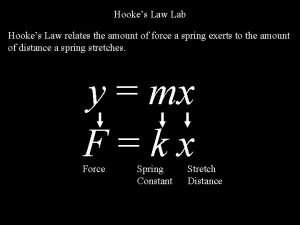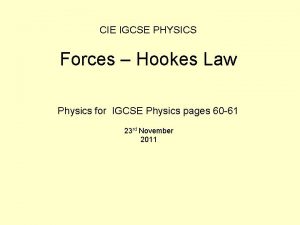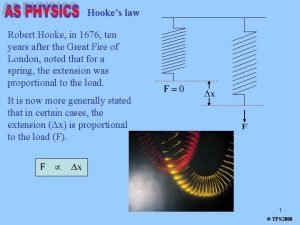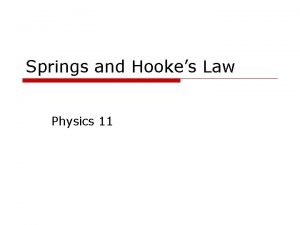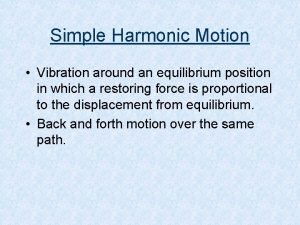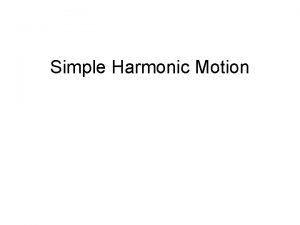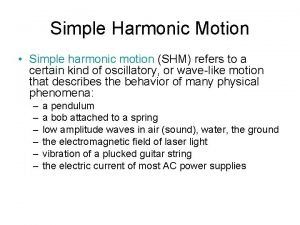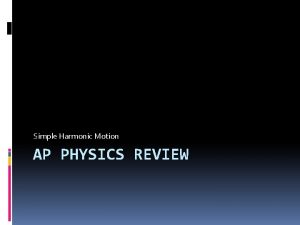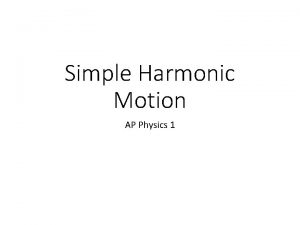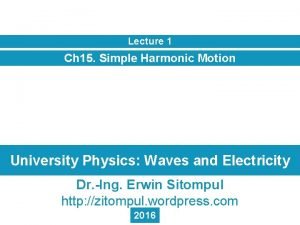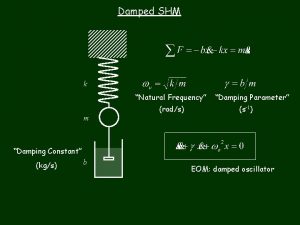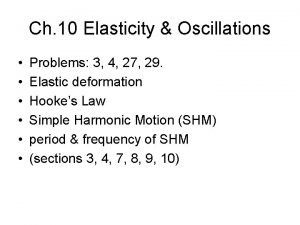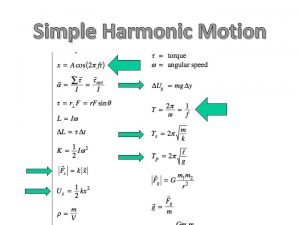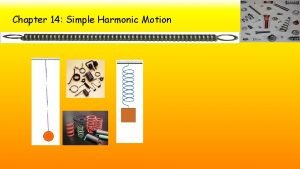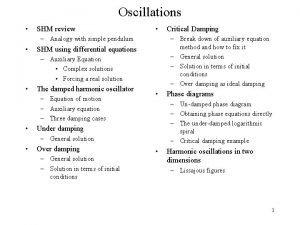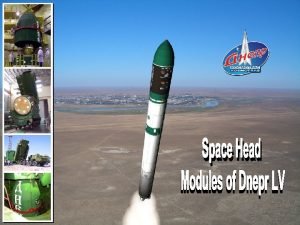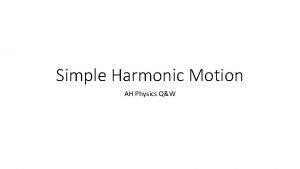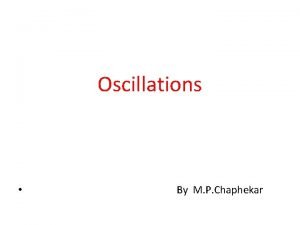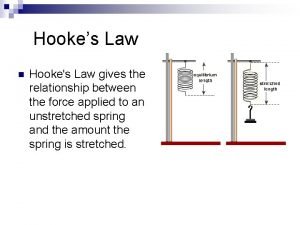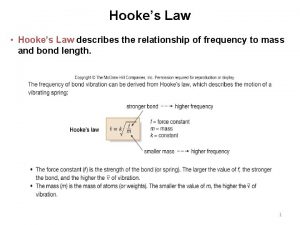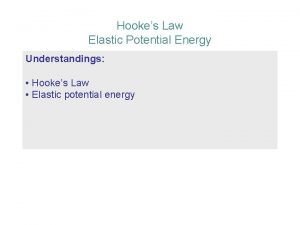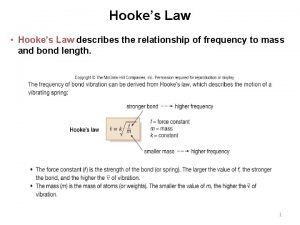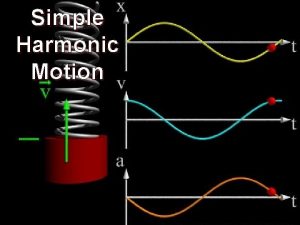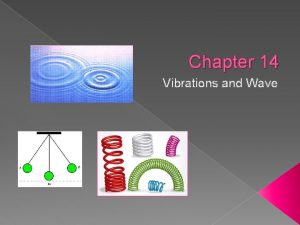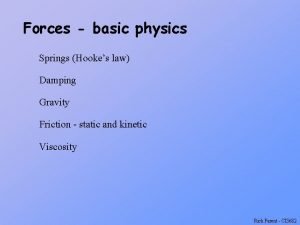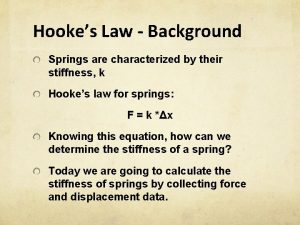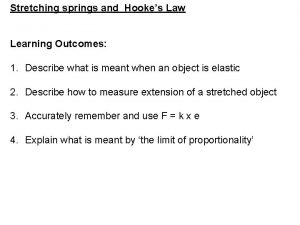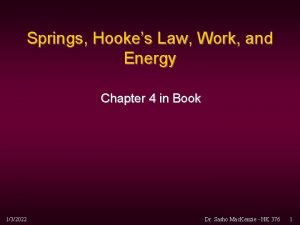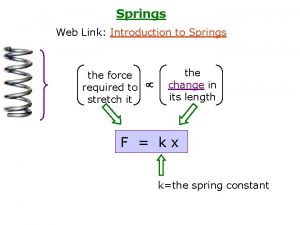SHM 1 Springs ACT Hookes Law The force






























![Simple Harmonic Motion: x(t) = [A]cos( t) v(t) = -[A ]sin( t) a(t) = Simple Harmonic Motion: x(t) = [A]cos( t) v(t) = -[A ]sin( t) a(t) =](https://slidetodoc.com/presentation_image_h2/a8f3a28fc212391f39789b6095c2d0e7/image-31.jpg)





- Slides: 36

SHM -1

Springs ACT • Hooke’s Law: The force exerted by a spring is proportional to the distance the spring is stretched or compressed from its relaxed position. – FX = -k x Where x is the displacement from the relaxed position and k is the constant of proportionality. What is force of spring when it is stretched as shown below. A) F > 0 B) F =relaxed 0 position C) F < 0 FX = - kx < 0 x>0 x x=0 14

Spring ACT A mass on a spring oscillates back & forth with simple harmonic motion of amplitude A. A plot of displacement (x) versus time (t) is shown below. At what points during its oscillation is the magnitude of the acceleration of the block biggest? 1. When x = +A or -A (i. e. maximum displacement) CORREC T 2. When x = 0 (i. e. zero displacement) 3. The acceleration of the mass is constant F=ma +A x t -A 17

Potential Energy in Spring • Force of spring is Conservative – F = -k x – W = -1/2 k x 2 Force work x – Work done only depends on initial and final position – Define Potential Energy Uspring = ½ k x 2 20

Oscillations (whether sinusoidal or otherwise) have some common characteristics: 1. They take place around an equilibrium position; 2. The motion is periodic and repeats with each cycle.

Periodic Motion Period: time required for one cycle of periodic motion Frequency: number of oscillations per unit time The frequency unit is called a hertz (Hz):

Frequency and Period

Example: Radio Station Frequency and Period What is the oscillation period of an FM radio station that broadcasts at 100 MHz? Note that 1/Hz = s

Simple Harmonic Motion A spring exerts a restoring force that is proportional to the displacement from equilibrium:

Simple Harmonic Motion A mass on a spring has a displacement as a function of time that is a sine or cosine curve: A is called the amplitude of the motion.

Simple Harmonic Motion If we call the period of the motion T (this is the time to complete one full cycle) we can write the position as a function of time as: It is then straightforward to show that the position at time t + T is the same as the position at time t (one period earlier), as we would expect.

Connections between Uniform Circular Motion and Simple Harmonic Motion An object in simple harmonic motion has the same motion as one component of an object in uniform circular motion:

Connections between Uniform Circular Motion and Simple Harmonic Motion Uniform circular motion projected into one dimension is simple harmonic motion (SHM). Consider a particle rotating ccw, with the angle f increasing linearly with time:

Connections between Uniform Circular Motion and Simple Harmonic Motion Here, the object in circular motion has an angular speed of where T is the period of motion of the object in simple harmonic motion.

Connections between Uniform Circular Motion and Simple Harmonic Motion The position as a function of time: The angular frequency:

Connections between Uniform Circular Motion and Simple Harmonic Motion The velocity as a function of time: And the acceleration: Both of these are found by taking components of the circular motion quantities.

The Period of a Mass on a Spring Since the force on a mass on a spring is proportional to the displacement, and also to the acceleration, we find that. Substituting the time dependencies of a and x gives:

The Period of a Mass on a Spring Therefore, the period is:

Mass+Spring Simple Harmonic Motion In simple harmonic motion (SHM), the acceleration, and thus the net force, are both proportional to and oppositely directed from the displacement from the equilibrium position. A = amplitude w = angular frequency d = phase

SHM Prototype Experiment Consider Fig. (a). An airtrack glider attached to a spring. The glider is pulled a distance A from its rest position and released. Fig. (b) shows a graph of the motion of the glider, as measured each 1/20 of a second. The graphs on the right show the position and velocity of the glider from the same measurements. We see that A=0. 17 m and T=1. 60 s. Therefore the oscillation frequency of the system is f = 0. 625 Hz

Two Oscillating Systems The diagram shows two identical masses attached to two identical springs and resting on a horizontal frictionless surface. Spring 1 is stretched to 5 cm, spring 2 is stretched to 10 cm, and the masses are released at the same time. Which mass reaches the equilibrium position first? Because k and m are the same, the systems have the same period, so they must return to equilibrium at the same time. The frequency and period of SHM are independent of amplitude.

Clicker Question 1 Shown are two mass + spring systems. The blocks have the same mass. When set into oscillation, what is the relation between the oscillation periods T 1, 2 of the two systems? (a) T 1>T 2 (b) T 1=T 2 (c) T 1<T 2 (d) Need to know m and k to answer

Example: A Block on a Spring A 2. 00 kg block is attached to a spring as shown. The force constant of the spring is k = 196 N/m. The block is held a distance of 5. 00 cm from equilibrium and released at t = 0. (a) Find the angular frequency w, the frequency f, and the period T. (b) Write an equation for x vs. time.

Example: A System in SHM An air-track glider is attached to a spring, pulled 20 cm to the right, and released at t-=0. It makes 15 complete oscillations in 10 s. a. What is the period of oscillation? b. What is the object’s maximum speed? c. What is its position and velocity at t=0. 80 s?

Example: Finding the Time A mass, oscillating in simple harmonic motion, starts at x = A and has period T. At what time, as a fraction of T, does the mass first pass through x = ½A?

The Phase Constant But what if f is not zero at t=0? A phase constant f¹ 0 means that the rotation starts at a different point on the circle, implying different initial conditions.

SHM Initial Conditions

***Energy *** • A mass is attached to a spring and set to motion. The maximum displacement is x=A – SWnc = DK + DU – 0 = DK + DU or Energy U+K is constant! Energy = ½ k x 2 + ½ m v 2 – At maximum displacement x=A, v = 0 PES Energy = ½ k A 2 + 0 – At zero displacement x = 0 Energy = 0 + ½ mvm 2 Since Total Energy is same 0 ½ k A 2 = ½ m v m 2 m vm = sqrt(k/m) A x=0 x x 25

Preflight 3+4 A mass on a spring oscillates back & forth with simple harmonic motion of amplitude A. A plot of displacement (x) versus time (t) is shown below. At what points during its oscillation is the total energy (K+U) of the mass and spring a maximum? (Ignore gravity). 1. When x = +A or -A (i. e. maximum displacement) 2. When x = 0 (i. e. zero displacement) CORRECT 3. The energy of the system is constant. +A x t -A 27

Preflight 1+2 A mass on a spring oscillates back & forth with simple harmonic motion of amplitude A. A plot of displacement (x) versus time (t) is shown below. At what points during its oscillation is the speed of the block biggest? 1. When x = +A or -A (i. e. maximum displacement) CORREC 2. When x = 0 (i. e. zero displacement) T 3. The speed of the mass is constant “There is no potential energy at x=0 since U=1/2 kx^2=0, therefore allowing all the energy of the spring to be allocated toward KE. x +A t -A 29
![Simple Harmonic Motion xt Acos t vt A sin t at Simple Harmonic Motion: x(t) = [A]cos( t) v(t) = -[A ]sin( t) a(t) =](https://slidetodoc.com/presentation_image_h2/a8f3a28fc212391f39789b6095c2d0e7/image-31.jpg)
Simple Harmonic Motion: x(t) = [A]cos( t) v(t) = -[A ]sin( t) a(t) = -[A 2]cos( t) xmax = A vmax = A amax = A 2 OR x(t) = [A]sin( t) v(t) = [A ]cos( t) a(t) = -[A 2]sin( t) Period = T (seconds per cycle) Frequency = f = 1/T (cycles per second) Angular frequency = = 2 f = 2 /T For spring: 2 = k/m 36

Example A 3 kg mass is attached to a spring (k=24 N/m). It is stretched 5 cm. At time t=0 it is released and oscillates. Which equation describes the position as a function of time x(t) = A) 5 sin( t) B) 5 cos( t) C) 24 sin( t) D) 24 cos( t) E) -24 cos( t) We are told at t=0, x = +5 cm. x(t) = 5 cos( t) only one that works. 39

Example A 3 kg mass is attached to a spring (k=24 N/m). It is stretched 5 cm. At time t=0 it is released and oscillates. What is the total energy of the block spring system? A) 0. 03 J B). 05 J C). 08 J E=U+K At t=0, x = 5 cm and v=0: E = ½ k x 2 + 0 = ½ (24 N/m) (5 cm)2 = 0. 03 J 43

Example A 3 kg mass is attached to a spring (k=24 N/m). It is stretched 5 cm. At time t=0 it is released and oscillates. What is the maximum speed of the block? A). 45 m/s B). 23 m/s C). 14 m/s E=U+K When x = 0, maximum speed: E = ½ m v 2 + 0. 03 = ½ 3 kg v 2 v =. 14 m/s 46

Example A 3 kg mass is attached to a spring (k=24 N/m). It is stretched 5 cm. At time t=0 it is released and oscillates. How long does it take for the block to return to x=+5 cm? A) 1. 4 s B) 2. 2 s C) 3. 5 s = sqrt(k/m) = sqrt(24/3) = 2. 83 radians/sec Returns to original position after 2 radians T = 2 / = 6. 28 / 2. 83 = 2. 2 seconds

• Springs Summary – F = -kx – U = ½ k x 2 – = sqrt(k/m) • Simple Harmonic Motion – Occurs when have linear restoring force F= -kx – x(t) = [A] cos( t) or [A] sin( t) – v(t) = -[A ] sin( t) or [A ] cos( t) – a(t) = -[A 2] cos( t) or -[A 2] sin( t)
 Hooke's law in som
Hooke's law in som Hooke's law formula
Hooke's law formula Site:slidetodoc.com
Site:slidetodoc.com Examples of hookes law
Examples of hookes law Hookes law
Hookes law Define hooke's law
Define hooke's law Equilibrium position of a wave
Equilibrium position of a wave How to find the restoring force of a spring
How to find the restoring force of a spring Frequency of shm formula
Frequency of shm formula Restoring force physics
Restoring force physics Shm ap physics 1
Shm ap physics 1 Harmonic equation
Harmonic equation Slidetodoc
Slidetodoc Heavy damping graph
Heavy damping graph Graphical representation of shm
Graphical representation of shm Shm k
Shm k Frequency of shm
Frequency of shm Shm reference circle
Shm reference circle Vmax= aw
Vmax= aw The cone of a loudspeaker vibrates in shm
The cone of a loudspeaker vibrates in shm Lissajous figures in shm
Lissajous figures in shm Structural health monitoring aircraft
Structural health monitoring aircraft Shm
Shm Shm
Shm Period of simple harmonic motion
Period of simple harmonic motion Damped oscillation
Damped oscillation Macbeth summary
Macbeth summary Newton's first law and second law and third law
Newton's first law and second law and third law Newton's first law of motion
Newton's first law of motion Boyle's law charles law avogadro's law
Boyle's law charles law avogadro's law Avogadro's law constants
Avogadro's law constants Hình ảnh bộ gõ cơ thể búng tay
Hình ảnh bộ gõ cơ thể búng tay Lp html
Lp html Bổ thể
Bổ thể Tỉ lệ cơ thể trẻ em
Tỉ lệ cơ thể trẻ em Gấu đi như thế nào
Gấu đi như thế nào Thang điểm glasgow
Thang điểm glasgow

